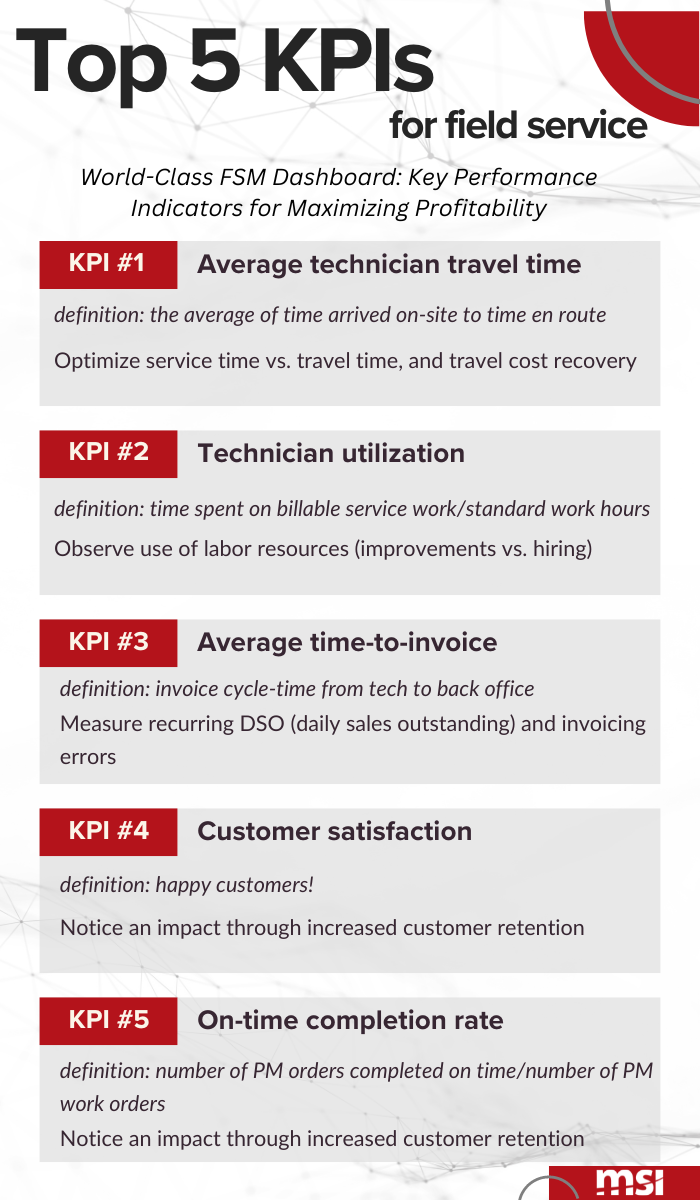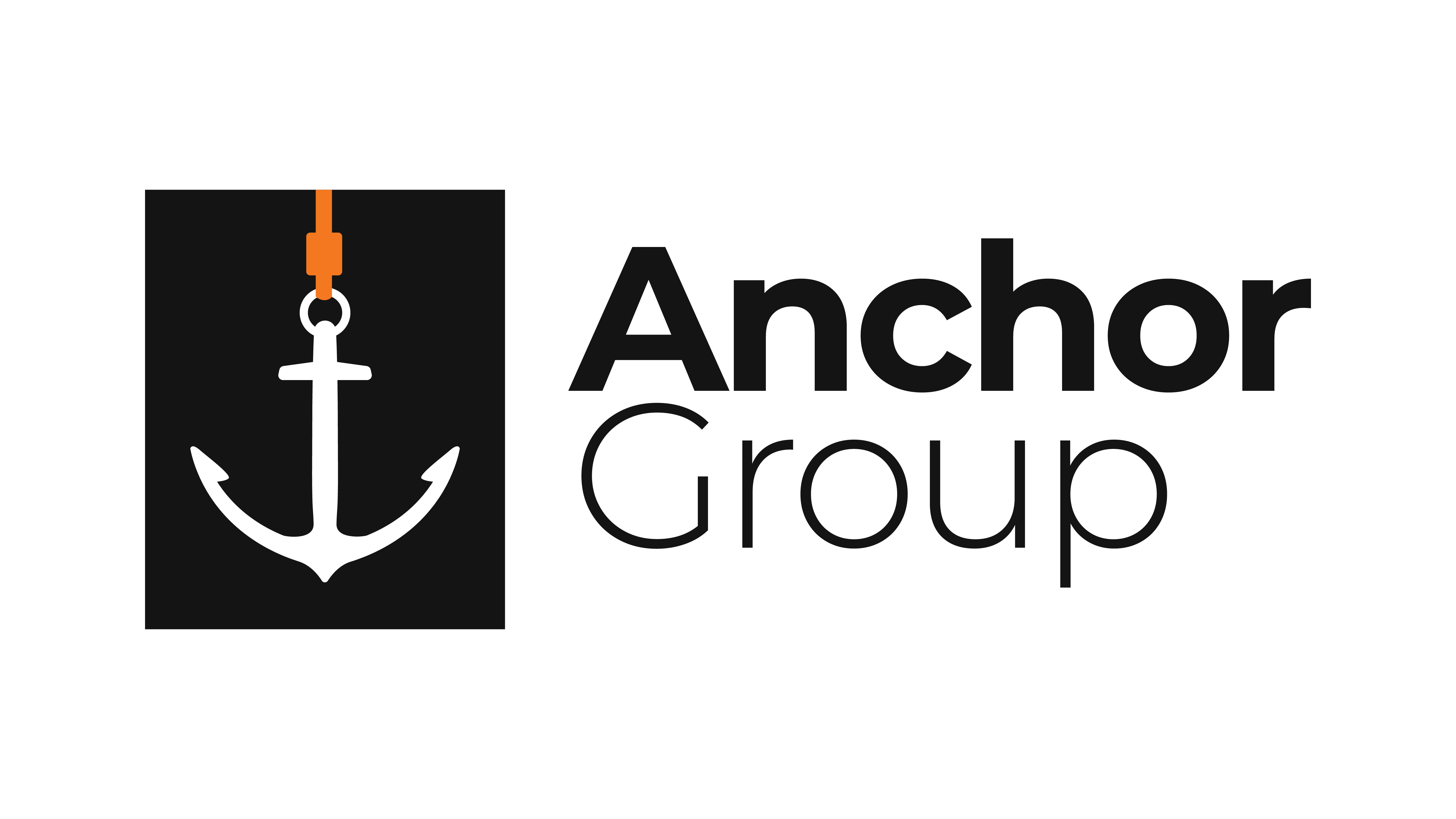What metrics are you currently tracking within your field service business to measure success?
The fastest and best way to increase your profitability is to have a tailored group of metrics for your company’s individual needs.
Key Performance Indicators, or KPIs, are the metrics you’ve been looking for. Measuring areas where you excel is just as valuable as knowing where you need to improve. Using data from the KPIs you collect can help inform your actions to stabilize the overall health of your business because “what gets measured, gets done.”
But, which KPIs should you focus on? There is no one-size-fits-all formula, but there are options to choose from. Variations between field service businesses from company size, number of technicians, industry, and goals must be taken under consideration when creating your unique blend of KPIs.
Through conducting market research, we have established the Top 5 KPIs to implement and track in order to maximize profitability. Keep reading to learn what they are, how they are tracked, and why they matter.

1. Average technician travel time
Measuring the travel times of your technicians can open up a world of data. How long your technicians are spending traveling, how long delays take, if there are truck rolls, etc. Tracking the average technician travel time will provide a number base over time that can be used to find and explain trends or anomalies.
This is calculated by finding the average of the time arrived on-site and the time spent en route. As an offline-capable mobile application, Service Pro Mobile’s ability to streamline the collection and classification of labor hours allows data to feed into stakeholder reporting, which can be filtered by technician, date, and more.
Possessing this number can give stakeholders visibility into travel time as an operational cost. More data in place means more ability to track and fine-tune expenses, and lower cost = more profitable work orders.
2. Technician utilization
Technician utilization is the time spent on billable service work/standard work hours. In other words, it is a measure of how much time technicians spend in active work mode.
Technician utilization is measured most efficiently within an automated system like Service Pro. Technicians start the process by capturing their hours worked within the Service Pro Mobile app, where the hours are classified via labor codes. Then, in Service Pro an automatically generated custom number is created to measure against the labor hours, and there you have the utilization percentage. Use this number to see where you compare to industry benchmarks. Currently, industry data from our research highlights a benchmark of 70% billable utilization.
If you are looking to increase your percentage, consider using a feature like Service Pro’s Business Intelligence to help you gather data to increase your utilization, and look at what other possible inefficiencies could be influencing low levels of billable time.
3. Average time-to-invoice
Average time-to-invoice is the average amount of time between an invoice being completed by the technician to being processed in the back office.
The process starts by capturing the time work is completed in the field through Service Pro Mobile. This sends a notification to the stakeholder who then reviews and completes the order in the back office. Service Pro runs a calculation with the delta between time completed in the field and time the order is completed/invoiced.
Field service automation can eliminate time spent performing calculations like this manually. Manual invoicing can lead to glacially slow invoice cycle times and increased errors, which can tank your customer satisfaction and trust. Slow invoicing cycle times can be shortened dramatically by transitioning from paper and manual invoices to an automated field service platform. Switching to digital forms is more environmentally friendly, more efficient, and easier for technicians to use in the field and to communicate data to the back office.
A Note on ERPs
This is the point where a company's ERP system comes into play. Just as field service automation shortens the time to invoice, automation in your back office can do the same. For example, if your company uses NetSuite ERP, there are a number of different ways you can use automation to speed up your average time-to-invoice, such as:
- Using workflows to set up approval processes to validate invoice data
- Dynamically sourcing data in fully customized PDF invoices
- Automating email validation for customer invoice recipients
Again, the exact automation that you can put in place will depend on your specific ERP system and how it is configured. You may need to hire a developer to assist you in setting up some of the more advanced automation.
Remember also that each of the KPIs we are discussing needs to be tracked using up-to-date, accurate data in order to be helpful. This reporting is also something that you can achieve in a robust ERP system.
4. Customer satisfaction
Customer satisfaction is straightforward, understanding how satisfied and happy your customers are with your product or services. Measuring CSAT is less about looking for one defining number, but a more holistic overview of your services and process from a customer's point of view.
Opening up pathways to visibility and communication is another way to fuel higher customer satisfaction.
With feature add-ons such as Tech Tracker, technicians can notify customers of their transit status and ETA’s, ensuring the customer’s time is respected and valued.
Surveys are an easy and direct way to ask and receive customer feedback. With a field service platform like Service Pro, surveys can be automatically triggered when the service is completed. When feedback is received, data can be funneled into Service Pro reporting. Calculations and filtering can be applied to this data for tracking CSAT by customer, technician, division, and more.
5. Preventative maintenance
Preventative maintenance encompasses regular and routine maintenance that is performed with the goal of preventing future problems, such as unexpected breakages or failure.
To begin, stakeholders build out their service agreements and schedules using Service Pro Contracts. Once built, Service Pro recommends which Preventative Maintenance orders to generate. Generated PM visits flow to the connected Service Pro Scheduler, ready to be planned and scheduled out. The date and timestamps are benchmarked in the system, allowing stakeholders to track when and what was completed on time.
If you perform any kind of preventative maintenance, there is no room for error when it comes to service records. The success of PM relies on details from the past, present, and future of the equipment. Storing it all in one place, with an efficient digital flow between the field and back office will do wonders for your daily efficiency, and your overall profitability.
Conclusion
No matter what industry you’re in, tracking Key Performance Indicators is critical to measuring success. Basic KPI tracking alone might show some basic trends, but tailoring your KPIs to your specific company will really blow your goals out of the water and understand where you fall alongside your competitors. The key is to focus on improving a few KPIs over time, and watch as your profitability begins to soar.
To become a KPI expert, read out Edition 1 of "Top 5 Field Service KPIs to Track" here.

If you want to see more KPIs and how they can help you, check out our Edition 2 of “Top 5 Field Service KPIs to Track” for KPIs 5-10, with a bonus #11.
About MSI Data
MSI Data is headquartered in Milwaukee, WI. Service Pro by MSI Data helps field service companies maximize the profitability of their service operations by giving service technicians the access and information they need to get work orders done right, the first time. Unlock visibility into areas you didn’t have before; identify key profit indicators, observe warranty claims, and optimize your business to collect the revenue you've earned.
